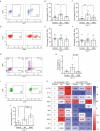GAS6 signaling tempers Th17 development in patients with multiple sclerosis and helminth infection
- PMID: 33347509
- PMCID: PMC7785232
- DOI: 10.1371/journal.ppat.1009176
GAS6 signaling tempers Th17 development in patients with multiple sclerosis and helminth infection
Abstract
Multiple sclerosis (MS) is a highly disabling neurodegenerative autoimmune condition in which an unbalanced immune response plays a critical role. Although the mechanisms remain poorly defined, helminth infections are known to modulate the severity and progression of chronic inflammatory diseases. The tyrosine kinase receptors TYRO3, AXL, and MERTK (TAM) have been described as inhibitors of the immune response in various inflammatory settings. We show here that patients with concurrent natural helminth infections and MS condition (HIMS) had an increased expression of the negative regulatory TAM receptors in antigen-presenting cells and their agonist GAS6 in circulating CD11bhigh and CD4+ T cells compared to patients with only MS. The Th17 subset was reduced in patients with HIMS with a subsequent downregulation of its pathogenic genetic program. Moreover, these CD4+ T cells promoted lower levels of the co-stimulatory molecules CD80, CD86, and CD40 on dendritic cells compared with CD4+ T cells from patients with MS, an effect that was GAS6-dependent. IL-10+ cells from patients with HIMS showed higher GAS6 expression levels than Th17 cells, and inhibition of phosphatidylserine/GAS6 binding led to an expansion of Th17 effector genes. The addition of GAS6 on activated CD4+ T cells from patients with MS restrains the Th17 gene expression signature. This cohort of patients with HIMS unravels a promising regulatory mechanism to dampen the Th17 inflammatory response in autoimmunity.
Conflict of interest statement
The authors have declared that no competing interests exist.
Figures






Similar articles
-
Natural Killer Cells Regulate Th17 Cells After Autologous Hematopoietic Stem Cell Transplantation for Relapsing Remitting Multiple Sclerosis.Front Immunol. 2018 May 7;9:834. doi: 10.3389/fimmu.2018.00834. eCollection 2018. Front Immunol. 2018. PMID: 29867923 Free PMC article. Clinical Trial.
-
miR-27a and miR-214 exert opposite regulatory roles in Th17 differentiation via mediating different signaling pathways in peripheral blood CD4+ T lymphocytes of patients with relapsing-remitting multiple sclerosis.Immunogenetics. 2016 Jan;68(1):43-54. doi: 10.1007/s00251-015-0881-y. Epub 2015 Nov 13. Immunogenetics. 2016. PMID: 26563334
-
Does helminth activation of toll-like receptors modulate immune response in multiple sclerosis patients?Front Cell Infect Microbiol. 2012 Aug 24;2:112. doi: 10.3389/fcimb.2012.00112. eCollection 2012. Front Cell Infect Microbiol. 2012. PMID: 22937527 Free PMC article. Review.
-
IL-11 Induces Th17 Cell Responses in Patients with Early Relapsing-Remitting Multiple Sclerosis.J Immunol. 2015 Jun 1;194(11):5139-49. doi: 10.4049/jimmunol.1401680. Epub 2015 Apr 20. J Immunol. 2015. PMID: 25895532
-
Growth arrest-specific gene 6 (GAS6). An outline of its role in haemostasis and inflammation.Thromb Haemost. 2008 Oct;100(4):604-10. doi: 10.1160/th08-04-0253. Thromb Haemost. 2008. PMID: 18841281 Review.
Cited by
-
Management of cell death in parasitic infections.Semin Immunopathol. 2021 Aug;43(4):481-492. doi: 10.1007/s00281-021-00875-8. Epub 2021 Jul 19. Semin Immunopathol. 2021. PMID: 34279684 Free PMC article. Review.
-
Proteolysis of TAM receptors in autoimmune diseases and cancer: what does it say to us?Cell Death Dis. 2025 Mar 5;16(1):155. doi: 10.1038/s41419-025-07480-9. Cell Death Dis. 2025. PMID: 40044635 Free PMC article. Review.
-
The Role of Intestinal Microbial Metabolites in the Immunity of Equine Animals Infected With Horse Botflies.Front Vet Sci. 2022 Jun 22;9:832062. doi: 10.3389/fvets.2022.832062. eCollection 2022. Front Vet Sci. 2022. PMID: 35812868 Free PMC article.
-
Coevolutionary interplay: Helminths-trained immunity and its impact on the rise of inflammatory diseases.Elife. 2025 Apr 15;14:e105393. doi: 10.7554/eLife.105393. Elife. 2025. PMID: 40231720 Free PMC article. Review.
-
Interleukin-18 and -10 may be associated with lymph node metastasis in breast cancer.Oncol Lett. 2021 Apr;21(4):253. doi: 10.3892/ol.2021.12515. Epub 2021 Feb 3. Oncol Lett. 2021. PMID: 33664817 Free PMC article.
References
Publication types
MeSH terms
Substances
Grants and funding
LinkOut - more resources
Full Text Sources
Research Materials
Miscellaneous

